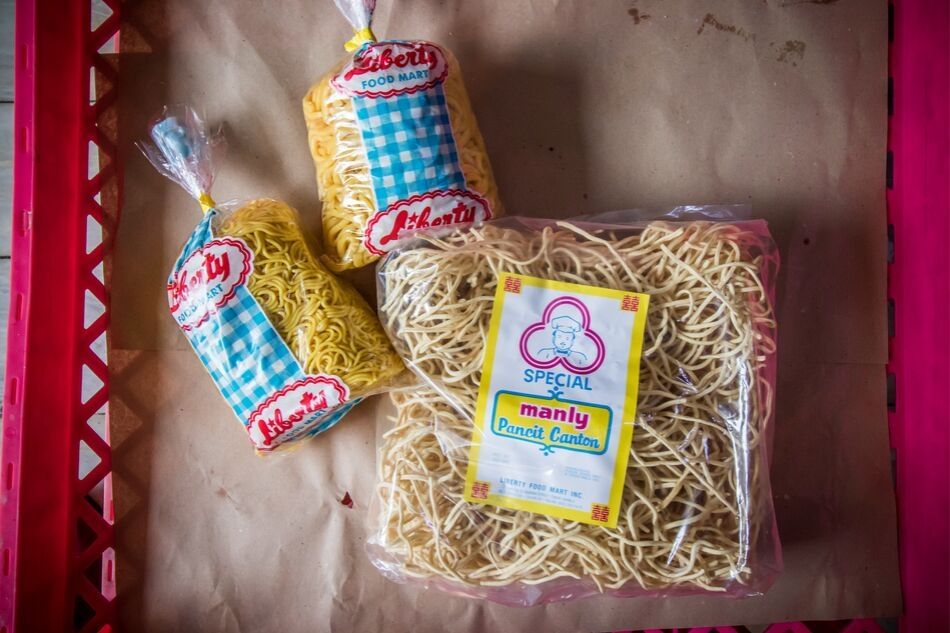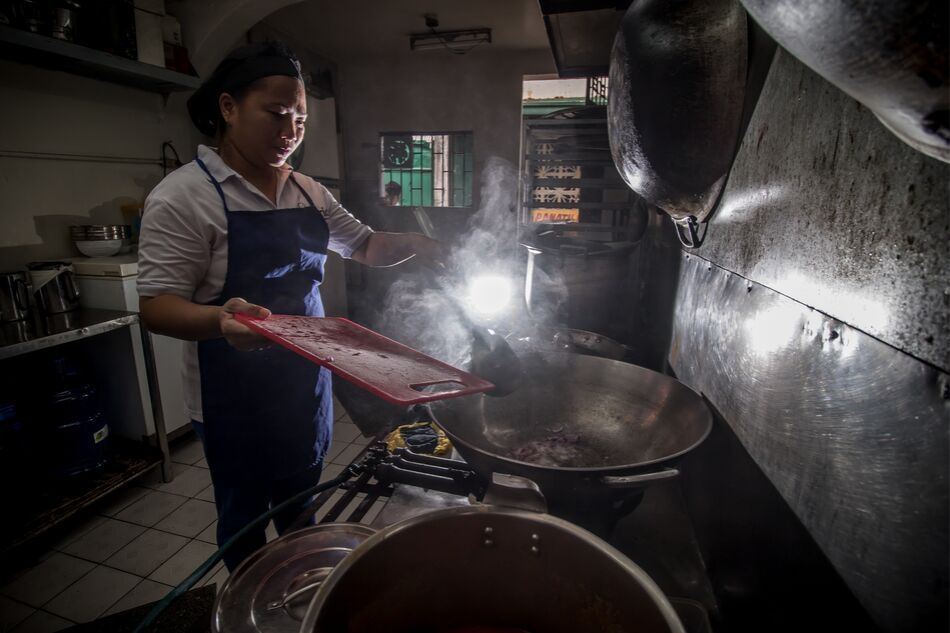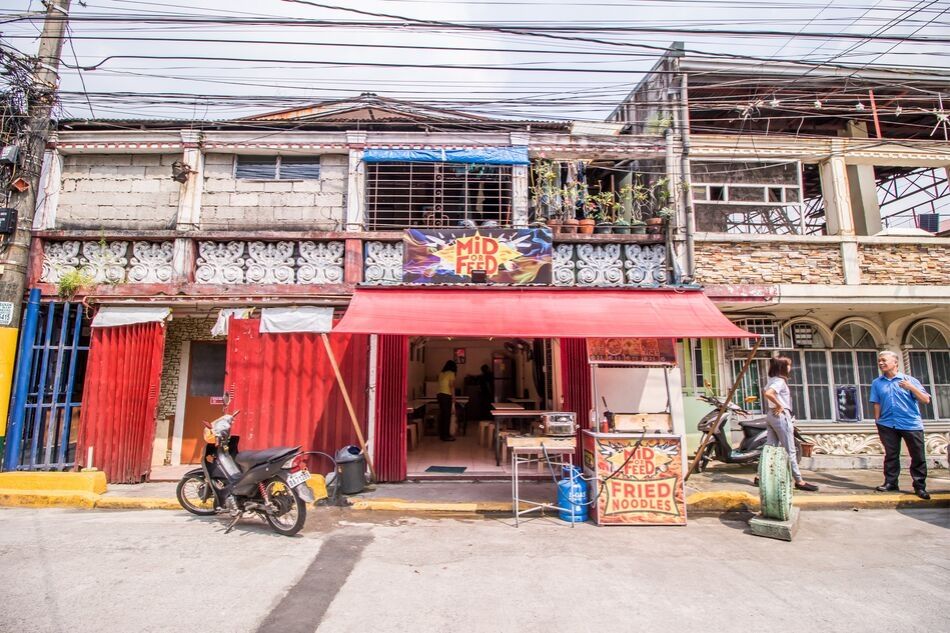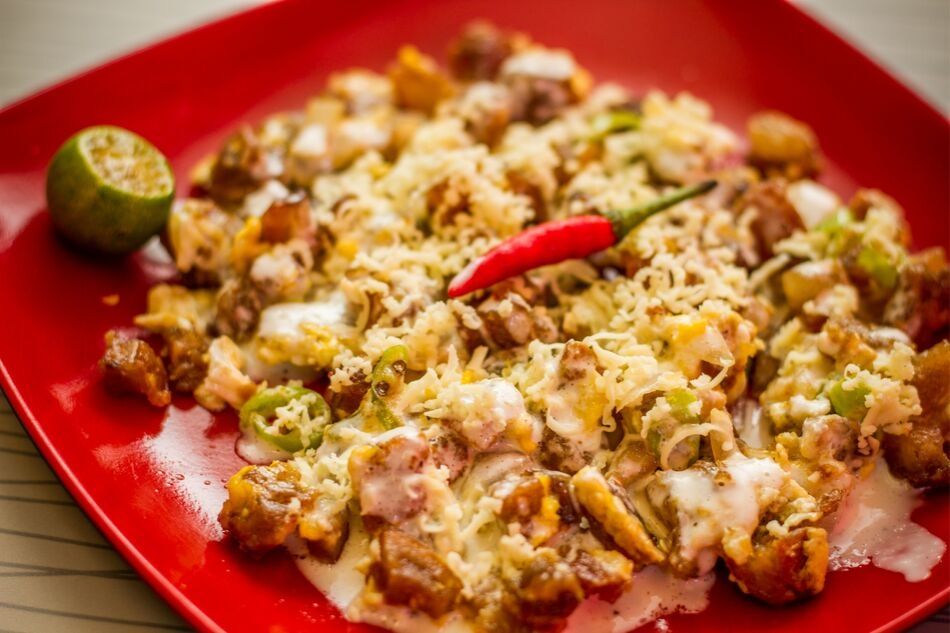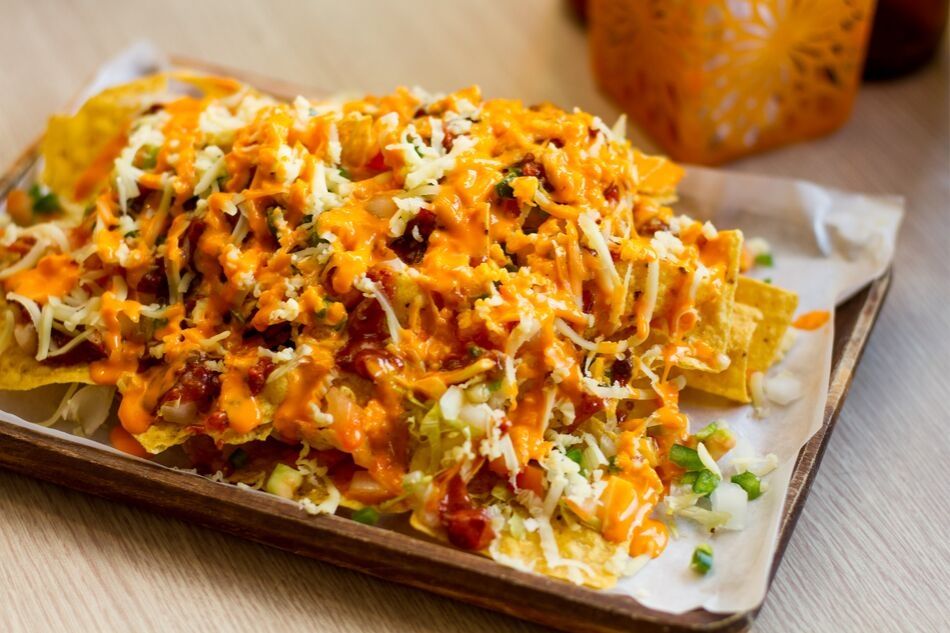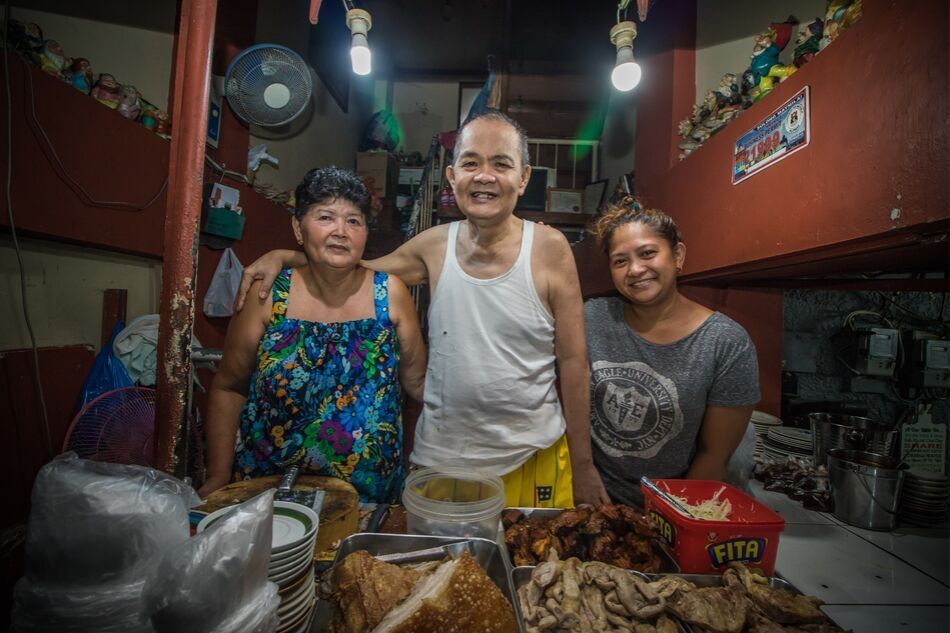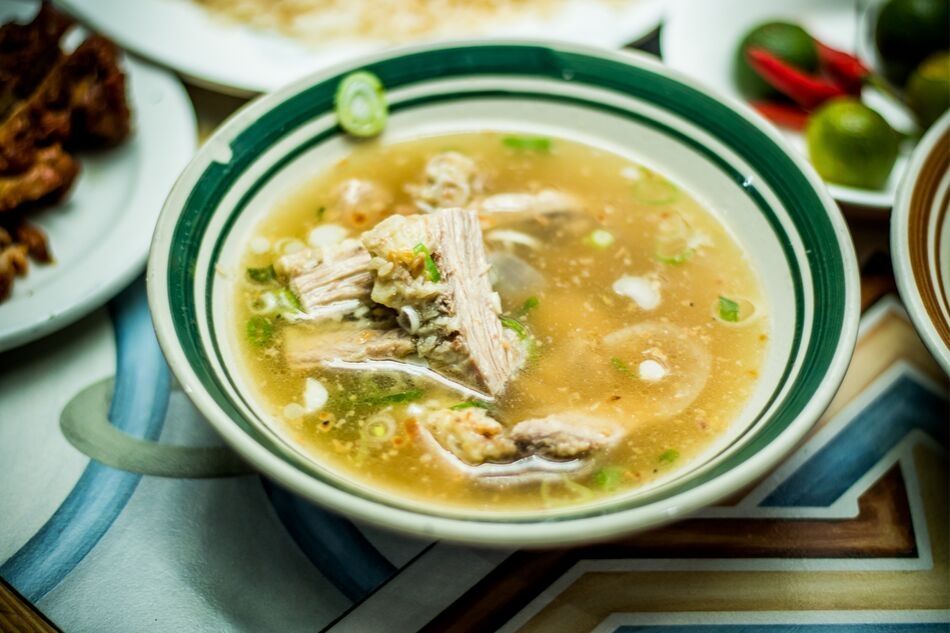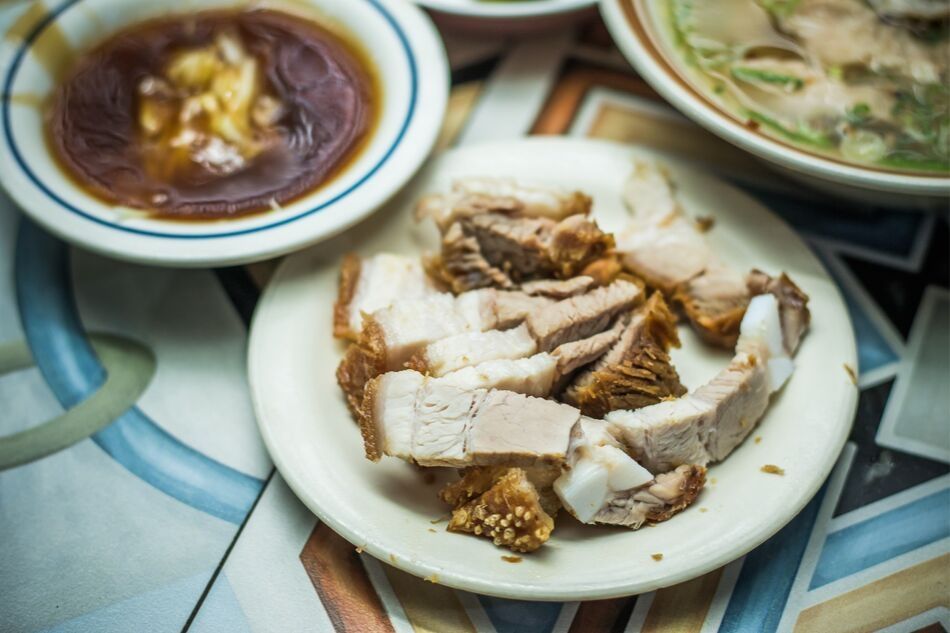“You’ll never grow hungry in Tondo:” Where to eat in Mayor Isko’s ‘hood, an expert’s guide | ABS-CBN

Welcome, Kapamilya! We use cookies to improve your browsing experience. Continuing to use this site means you agree to our use of cookies. Tell me more!
“You’ll never grow hungry in Tondo:” Where to eat in Mayor Isko’s ‘hood, an expert’s guide
“You’ll never grow hungry in Tondo:” Where to eat in Mayor Isko’s ‘hood, an expert’s guide
Jenny B. Orillos
Published Oct 05, 2019 06:29 PM PHT
|
Updated Oct 08, 2019 03:03 PM PHT
Tondo may not usually come to mind for food trips, but a recent ANCX story on a favorite hangout of Mayor Isko Moreno inspired us to further explore this side of Manila. Amidst established carinderia and street food joints are hole-in-the-wall restaurants right next door to houses. Hungry Tondo residents simply walk to a family-owned restaurant across the street. It’s all in the neighborhood.
Tondo may not usually come to mind for food trips, but a recent ANCX story on a favorite hangout of Mayor Isko Moreno inspired us to further explore this side of Manila. Amidst established carinderia and street food joints are hole-in-the-wall restaurants right next door to houses. Hungry Tondo residents simply walk to a family-owned restaurant across the street. It’s all in the neighborhood.
But it’s not just traditional eateries that thrive. Millennials are at the helm of newer concepts, so you’ll see trends like unlimited chicken wings and Korean barbecue, milk teas and boodle fights. Regardless of its past reputation as a rough neighborhood, at the heart of Tondo is a vibrant community that loves to eat out.
But it’s not just traditional eateries that thrive. Millennials are at the helm of newer concepts, so you’ll see trends like unlimited chicken wings and Korean barbecue, milk teas and boodle fights. Regardless of its past reputation as a rough neighborhood, at the heart of Tondo is a vibrant community that loves to eat out.
You may also like:
You may also like:
- How to eat your way through Cavite, birthplace of Philippine independence
- Revisiting old Taal through its ancestral homes and heirloom recipes
- From curacha to lamb lechon, Isabela is definitely more than just their pancit
- From tamales to morcon: how Pampanga’s sons are keeping the hometown cuisine alive
- A reintroduction to Vigan by way of its food
- How to eat your way through Cavite, birthplace of Philippine independence
- Revisiting old Taal through its ancestral homes and heirloom recipes
- From curacha to lamb lechon, Isabela is definitely more than just their pancit
- From tamales to morcon: how Pampanga’s sons are keeping the hometown cuisine alive
- A reintroduction to Vigan by way of its food
Tondo heritage
Tondo heritage
The whole district was undergoing clearing operations on the day we visited as we heard buzzwords like “bakbak,” “giba,” and “na-clearing kami” from the locals. It has left a trail of cleaner, clutter-free streets in its wake, all the more reason to venture into this oldest part of old Manila.
The whole district was undergoing clearing operations on the day we visited as we heard buzzwords like “bakbak,” “giba,” and “na-clearing kami” from the locals. It has left a trail of cleaner, clutter-free streets in its wake, all the more reason to venture into this oldest part of old Manila.
ADVERTISEMENT
Our guide was Tondo-born cultural heritage advocate, Prof. Mary Ann Venturina-Bulanadi, faculty member of the College of Fine Arts and Design at University of Santo Tomas, research fellow at the UST Research Center for Culture, Arts and Humanities and lecturer at the Philippine School of Interior Design. Her father, Dr. Alberto Venturina, served as community doctor and established a medical clinic in Velasquez Street in 1962 which continues to serve residents to this day.
Our guide was Tondo-born cultural heritage advocate, Prof. Mary Ann Venturina-Bulanadi, faculty member of the College of Fine Arts and Design at University of Santo Tomas, research fellow at the UST Research Center for Culture, Arts and Humanities and lecturer at the Philippine School of Interior Design. Her father, Dr. Alberto Venturina, served as community doctor and established a medical clinic in Velasquez Street in 1962 which continues to serve residents to this day.
We made our way to Mary Johnston Hospital along J. Nolasco Street. Founded in 1906, the present building was erected in 1908 through a donation by Daniel S. B. Johnston, an American Methodist layman, and named after his late missionary wife, Mary. The Sto. Niño de Tondo Parish Church along L. Chacon Street is another Tondo landmark.
We made our way to Mary Johnston Hospital along J. Nolasco Street. Founded in 1906, the present building was erected in 1908 through a donation by Daniel S. B. Johnston, an American Methodist layman, and named after his late missionary wife, Mary. The Sto. Niño de Tondo Parish Church along L. Chacon Street is another Tondo landmark.
We drove to Pritil Public Market in Juan Luna Street where Tondo’s home cooks and eateries get their supply of meat, fish, and vegetables. At Perlie’s Fresh Meat stall, we chanced upon pig’s blood (for dinuguan) and hamonado meat rolls. These are marinated in pineapple juice, 7-Up, seasonings, and orange food color, and are cooked and served like an embotido. We had palabok at Delia & Emy’s Eatery inside the market as our first meal of the day.
We drove to Pritil Public Market in Juan Luna Street where Tondo’s home cooks and eateries get their supply of meat, fish, and vegetables. At Perlie’s Fresh Meat stall, we chanced upon pig’s blood (for dinuguan) and hamonado meat rolls. These are marinated in pineapple juice, 7-Up, seasonings, and orange food color, and are cooked and served like an embotido. We had palabok at Delia & Emy’s Eatery inside the market as our first meal of the day.
Community bakery
Community bakery
For most residents along N. Zamora Street, the day begins with a trip to Liberty Bakery for hot pan de sal. “Malaman kasi ang pan de sal diyan atsaka mabigat. Kahit na malayo bumibili ako,” says Pacifico “Joy” Odra, whose family runs a pizza place several streets away.
For most residents along N. Zamora Street, the day begins with a trip to Liberty Bakery for hot pan de sal. “Malaman kasi ang pan de sal diyan atsaka mabigat. Kahit na malayo bumibili ako,” says Pacifico “Joy” Odra, whose family runs a pizza place several streets away.
The bakery was founded in 1940 by Juliana Santos then acquired in 1954 by Ah Nam, whose heirs manage it today. It has grown into Liberty Food Mart, with stalls in SM supermarkets under the Fresh-Baked brand. Ah Nam’s son, Henry Ah, introduced new products like affordable artisan sourdough breads, but it is the pan de sal, kababayan, merengue, egg pie, and siopao that Tondo residents have come to love.
The bakery was founded in 1940 by Juliana Santos then acquired in 1954 by Ah Nam, whose heirs manage it today. It has grown into Liberty Food Mart, with stalls in SM supermarkets under the Fresh-Baked brand. Ah Nam’s son, Henry Ah, introduced new products like affordable artisan sourdough breads, but it is the pan de sal, kababayan, merengue, egg pie, and siopao that Tondo residents have come to love.
ADVERTISEMENT
With the bakery’s proximity to Divisoria, carinderia and panciteria owners make a pit stop here from 6 to 8 am to buy breads, pancit miki, mami, or canton, says Jennifer Ah-Tan, Henry’s daughter. “Pati breadcrumbs bibilhin nila para gumawa ng sarili nilang sauce para sa palabok.” At Christmastime, buyers would order in bulk Liberty’s Jumbo Loaf then sell it at the public market. For close to 80 years, Liberty continues to serve Tondo as a community bakery.
With the bakery’s proximity to Divisoria, carinderia and panciteria owners make a pit stop here from 6 to 8 am to buy breads, pancit miki, mami, or canton, says Jennifer Ah-Tan, Henry’s daughter. “Pati breadcrumbs bibilhin nila para gumawa ng sarili nilang sauce para sa palabok.” At Christmastime, buyers would order in bulk Liberty’s Jumbo Loaf then sell it at the public market. For close to 80 years, Liberty continues to serve Tondo as a community bakery.
From carinderia to catering veterans
From carinderia to catering veterans
Mary Ann introduced us to the Africa family, known for their home-cooked meals in Gagalangin. In 1998, Geraldine Africa-Tosoc and her husband Engr. Noel Tosoc began selling food trays of pasta and viands. But when Noel worked abroad and Geraldine began working full time, the business slowed down. As they occasionally accepted food orders, Geraldine’s brother, Glenn Anthony, opened a carinderia around 2002, with his wife Hilda who did the cooking.
Mary Ann introduced us to the Africa family, known for their home-cooked meals in Gagalangin. In 1998, Geraldine Africa-Tosoc and her husband Engr. Noel Tosoc began selling food trays of pasta and viands. But when Noel worked abroad and Geraldine began working full time, the business slowed down. As they occasionally accepted food orders, Geraldine’s brother, Glenn Anthony, opened a carinderia around 2002, with his wife Hilda who did the cooking.
With requests for full catering services coming in, they began accepting events in 2004. Glenn barely knew anything about the business but he was determined to pursue his dream so he studied on his own and learned from each catering gig. By 2006, they officially registered as Africa’s Catering and Events Services, offering favorites such as Chicken Cordon Bleu, Special Sisig, Pork Hamonado, and Roast Beef.
With requests for full catering services coming in, they began accepting events in 2004. Glenn barely knew anything about the business but he was determined to pursue his dream so he studied on his own and learned from each catering gig. By 2006, they officially registered as Africa’s Catering and Events Services, offering favorites such as Chicken Cordon Bleu, Special Sisig, Pork Hamonado, and Roast Beef.
Family recipes were also part of the menu, such as Kare-kare de Pata y Rabo (perfected by Estrella, their mother), Pata Tim (by their late father, Dr. Martin Africa), and Noel’s special spicy laing. Hilda’s Chicken Cordon Bleu has become a standout because of the special garlic sauce initially created for tuna rolls. When Glenn paired it with the chicken, it became an instant hit. For pasta dishes, they serve French bread from Liberty Bakery.
Family recipes were also part of the menu, such as Kare-kare de Pata y Rabo (perfected by Estrella, their mother), Pata Tim (by their late father, Dr. Martin Africa), and Noel’s special spicy laing. Hilda’s Chicken Cordon Bleu has become a standout because of the special garlic sauce initially created for tuna rolls. When Glenn paired it with the chicken, it became an instant hit. For pasta dishes, they serve French bread from Liberty Bakery.
Many Tondo residents rely on the Africas to cater for birthdays, weddings, and funerals. For the Tondo fiesta, the family accepts orders for food trays. The business has also provided jobs to the neighborhood, including their head cook Almira Vencito and her family. The once humble Tondo carinderia now caters to bigger clients, proof of a family’s entrepreneurial spirit and cooking skill.
Many Tondo residents rely on the Africas to cater for birthdays, weddings, and funerals. For the Tondo fiesta, the family accepts orders for food trays. The business has also provided jobs to the neighborhood, including their head cook Almira Vencito and her family. The once humble Tondo carinderia now caters to bigger clients, proof of a family’s entrepreneurial spirit and cooking skill.
ADVERTISEMENT
Next generation eateries
Next generation eateries
Glenn and Hilda Africa’s sons—Martin, Matthew, and Marcus—recently set up their own place on R. Fernandez Street, taking after their parents’ entrepreneurial genes. Mid or Feed is named after an option in the popular online game Mobile Legends—something their market from nearby schools can relate to.
Glenn and Hilda Africa’s sons—Martin, Matthew, and Marcus—recently set up their own place on R. Fernandez Street, taking after their parents’ entrepreneurial genes. Mid or Feed is named after an option in the popular online game Mobile Legends—something their market from nearby schools can relate to.
The menu is arranged according to the three highest divisions in the game (Epic, Legend, and Mythic) and features nachos, cheese sticks, pasta, fritters, and burger steaks. Glenn’s legendary special sisig was bequeathed to his sons’ restaurant and is also a bestseller. Matthew, a hotel and restaurant management graduate, manages daily operations. Loyal customers flock to the restaurant after school. “Usually po mga players namin naglalaro sila dito, may dala po sila,” says Matthew.
The menu is arranged according to the three highest divisions in the game (Epic, Legend, and Mythic) and features nachos, cheese sticks, pasta, fritters, and burger steaks. Glenn’s legendary special sisig was bequeathed to his sons’ restaurant and is also a bestseller. Matthew, a hotel and restaurant management graduate, manages daily operations. Loyal customers flock to the restaurant after school. “Usually po mga players namin naglalaro sila dito, may dala po sila,” says Matthew.
Many of the newer restaurants open late in the afternoon, catering to students and office workers coming home hungry. For freshly-baked pizza, Tondo residents go to Chef-O at the corner of Velasquez and Peñalosa Streets. Jaimee Odra takes care of daily operations beginning at 3 pm. Her older brother, Mark Jefferson, worked as a cook in a hotel and a cruise ship before putting up Chef-O as head chef and baker.
Many of the newer restaurants open late in the afternoon, catering to students and office workers coming home hungry. For freshly-baked pizza, Tondo residents go to Chef-O at the corner of Velasquez and Peñalosa Streets. Jaimee Odra takes care of daily operations beginning at 3 pm. Her older brother, Mark Jefferson, worked as a cook in a hotel and a cruise ship before putting up Chef-O as head chef and baker.
The siblings first set up in Morayta in 2015 but had to close because of high overhead costs. They moved back home to Tondo and shifted their focus from making burgers to baking pizzas which has less competition. Today, they are one of the few surviving pizza places in the area. “Hindi nga po namin akalain na dito kami magbo-boom,” says Jaimee. They also supply schools and canteens.
The siblings first set up in Morayta in 2015 but had to close because of high overhead costs. They moved back home to Tondo and shifted their focus from making burgers to baking pizzas which has less competition. Today, they are one of the few surviving pizza places in the area. “Hindi nga po namin akalain na dito kami magbo-boom,” says Jaimee. They also supply schools and canteens.
Chef-O makes its own pizza sauce and thin crust by hand then bakes each pizza to order. We tried the bestseller Mighty Meaty, loaded with toppings and a good pizza sauce. Their pizza carbonara is a delicious play on pasta made to look like pizza. The spaghetti is covered in white sauce and pizza toppings (pepperoni, bacon, and beef). Business peaks between 10 pm and 1 am when residents have their pizza delivered for late-night cravings.
Chef-O makes its own pizza sauce and thin crust by hand then bakes each pizza to order. We tried the bestseller Mighty Meaty, loaded with toppings and a good pizza sauce. Their pizza carbonara is a delicious play on pasta made to look like pizza. The spaghetti is covered in white sauce and pizza toppings (pepperoni, bacon, and beef). Business peaks between 10 pm and 1 am when residents have their pizza delivered for late-night cravings.
ADVERTISEMENT
Classic comfort food
Classic comfort food
By 6 pm, we were ready for dinner at Rados Lechon, a small eatery in an alley called Simon and the corner of Varona Street. Owned by Conrado “Rado” Bautista, 65, the alley with the red walls transforms into a makeshift cooking area late in the afternoon. We chanced upon Mang Rado himself who was recovering from a stroke he suffered three months ago. He walked a little slowly but was still very lively and brimming with stories. Mang Rado says he used to do all the work, from purchasing meat from his suki in Pritil Market to cooking the main dishes. He has since trained family members on how to prepare their specialties.
By 6 pm, we were ready for dinner at Rados Lechon, a small eatery in an alley called Simon and the corner of Varona Street. Owned by Conrado “Rado” Bautista, 65, the alley with the red walls transforms into a makeshift cooking area late in the afternoon. We chanced upon Mang Rado himself who was recovering from a stroke he suffered three months ago. He walked a little slowly but was still very lively and brimming with stories. Mang Rado says he used to do all the work, from purchasing meat from his suki in Pritil Market to cooking the main dishes. He has since trained family members on how to prepare their specialties.
Mang Rado’s daughter-in-law Jasmin Bautista prepares orders at the open counter in front of their house. On the menu board are Rado’s famous dishes: lechon done kawali style, asado using dila ng baka, kamto or beef soup, and tumbong (large pork intestine soup), the mayor’s favorite. The eatery originated from Mang Rado’s sister but when her husband died, Mang Rado decided to continue the business in 1994 because that same year, he had lost his job as an electrician at the local distillery when it shut down.
Mang Rado’s daughter-in-law Jasmin Bautista prepares orders at the open counter in front of their house. On the menu board are Rado’s famous dishes: lechon done kawali style, asado using dila ng baka, kamto or beef soup, and tumbong (large pork intestine soup), the mayor’s favorite. The eatery originated from Mang Rado’s sister but when her husband died, Mang Rado decided to continue the business in 1994 because that same year, he had lost his job as an electrician at the local distillery when it shut down.
“Inimprove ko na lang nang dahan-dahan,” says Mang Rado of the early years. “Pag nakakausap ako ng kusinero ng Chinese, tinatanong ko kung papaano ang procedure.” A friend that worked at Wah Sun Panciteria in Florentino Torres Street in Sta. Cruz gave him tips on how to make lechon kawali and asado.
“Inimprove ko na lang nang dahan-dahan,” says Mang Rado of the early years. “Pag nakakausap ako ng kusinero ng Chinese, tinatanong ko kung papaano ang procedure.” A friend that worked at Wah Sun Panciteria in Florentino Torres Street in Sta. Cruz gave him tips on how to make lechon kawali and asado.
By 6:30 pm, people began to queue and occupy the long tables. Jasmin worked fast, chopping the lechon with precision then arranging it on a plate served with sweet, dark brown sauce and grated papaya. She then prepared an order of tumbong. She cleaved the intestine into small pieces, puts them into a bowl, added a pinch of salt, fried garlic, and sliced leeks before ladling the broth.
By 6:30 pm, people began to queue and occupy the long tables. Jasmin worked fast, chopping the lechon with precision then arranging it on a plate served with sweet, dark brown sauce and grated papaya. She then prepared an order of tumbong. She cleaved the intestine into small pieces, puts them into a bowl, added a pinch of salt, fried garlic, and sliced leeks before ladling the broth.
“Natutuhan ko ‘yang tumbong kainin sa Ongpin, sa may estero. Tapos tinuruan ako ng cook ng Chinese. ‘Pag hindi ka marunong maglinis niyan, hindi mo makakain ‘yan. Kaya nga tumbong eh,” Mang Rado says. The meat is tender with all but traces of the gaminess gone after hours of washing, cleaning, and boiling.
“Natutuhan ko ‘yang tumbong kainin sa Ongpin, sa may estero. Tapos tinuruan ako ng cook ng Chinese. ‘Pag hindi ka marunong maglinis niyan, hindi mo makakain ‘yan. Kaya nga tumbong eh,” Mang Rado says. The meat is tender with all but traces of the gaminess gone after hours of washing, cleaning, and boiling.
ADVERTISEMENT
Jasmin assembled the kamto with the same toppings, except the broth and meat are made from beef, like a nilaga. “Pero mas malinamnam, mas masarap,” says Mang Rado. Both soups are satisfying to slurp and to pour onto the large plate of savory, light brown fried rice.
Jasmin assembled the kamto with the same toppings, except the broth and meat are made from beef, like a nilaga. “Pero mas malinamnam, mas masarap,” says Mang Rado. Both soups are satisfying to slurp and to pour onto the large plate of savory, light brown fried rice.
Back in the day, they opened between 10 pm and 4 am, but when loyal customers requested them to open much earlier to avoid staying up late, Mang Rado began to serve food by 5:30 pm. Through word of mouth, non-residents also brave the queue to ensure they get a taste of these Tondo classics.
Back in the day, they opened between 10 pm and 4 am, but when loyal customers requested them to open much earlier to avoid staying up late, Mang Rado began to serve food by 5:30 pm. Through word of mouth, non-residents also brave the queue to ensure they get a taste of these Tondo classics.
Tondo night eats
Tondo night eats
Along Peñalosa Street was Corazon “Aling Kuring” Ocampo’s chicharonan which was popular in the ‘90s. “Tagaluto ang tatay ko,” says her son Carmelo, a friend of Kuya Joy Odra of Chef-O. “Noong college na ako, ako na ‘yung nagluluto.” When Aling Kuring died, the chicharonan was briefly continued by Carmelo and his wife. They bought pork skin from various sources. “‘Pag may laman, sa mga supermarket, kasi ‘yung sa kanila merong makakapal. ‘Pag mga balat lang, sa Pritil Market. Nag-iipon na sila noon para sa amin” says Carmelo.
Along Peñalosa Street was Corazon “Aling Kuring” Ocampo’s chicharonan which was popular in the ‘90s. “Tagaluto ang tatay ko,” says her son Carmelo, a friend of Kuya Joy Odra of Chef-O. “Noong college na ako, ako na ‘yung nagluluto.” When Aling Kuring died, the chicharonan was briefly continued by Carmelo and his wife. They bought pork skin from various sources. “‘Pag may laman, sa mga supermarket, kasi ‘yung sa kanila merong makakapal. ‘Pag mga balat lang, sa Pritil Market. Nag-iipon na sila noon para sa amin” says Carmelo.
He recalls the monok, a favorite pulutan in Tondo, sold in Angustia Street at 6 pm. To make it, the cook gathers the meat leftover from soup broths (pinaglagaan) from restaurants, which consists of beef, pork, and chicken. The meats are then torn into strips then cooked as adobong tuyo in a large kawali. “Masarap ‘yon sa kaning lamig,” says Carmelo.
He recalls the monok, a favorite pulutan in Tondo, sold in Angustia Street at 6 pm. To make it, the cook gathers the meat leftover from soup broths (pinaglagaan) from restaurants, which consists of beef, pork, and chicken. The meats are then torn into strips then cooked as adobong tuyo in a large kawali. “Masarap ‘yon sa kaning lamig,” says Carmelo.
Another pulutan is the abnoy, made from unhatched native chicken egg (bugok). It is boiled, breaded, and fried like the tukneneng but without food color so the coating is brown. It’s paired with a red vinegar.
Another pulutan is the abnoy, made from unhatched native chicken egg (bugok). It is boiled, breaded, and fried like the tukneneng but without food color so the coating is brown. It’s paired with a red vinegar.
ADVERTISEMENT
Locals used to wait for Lola Ellen’s sopas sinangag along Corcuera Street at 1 am. The sopas is made with utak ng baka then paired with fried rice and pritong talong with bagoong. It is eaten only after a drinking session. “Pangpababa,” says Kuya Joy.
Locals used to wait for Lola Ellen’s sopas sinangag along Corcuera Street at 1 am. The sopas is made with utak ng baka then paired with fried rice and pritong talong with bagoong. It is eaten only after a drinking session. “Pangpababa,” says Kuya Joy.
By the time the manginginom return home, the bakeries begin a new day of making breads at the crack of dawn. “Dito sa Tondo hindi ka magugutom. Kahit na anong oras ka gumising, may pagkain. Kaya ang tao rito, 24 hours may gising sa kalye,” says Kuya Joy.
By the time the manginginom return home, the bakeries begin a new day of making breads at the crack of dawn. “Dito sa Tondo hindi ka magugutom. Kahit na anong oras ka gumising, may pagkain. Kaya ang tao rito, 24 hours may gising sa kalye,” says Kuya Joy.
On our way home, we encountered more eateries filling up with people—even more reasons to come back. To outsiders, these eateries are perceived as a culinary adventure, but for Tondo residents, these are simply the comfort foods of home.
On our way home, we encountered more eateries filling up with people—even more reasons to come back. To outsiders, these eateries are perceived as a culinary adventure, but for Tondo residents, these are simply the comfort foods of home.
Photos by Paulo Valenzuela
ADVERTISEMENT
ADVERTISEMENT











